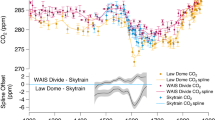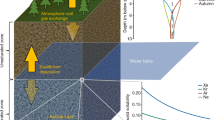Abstract
Rapid temperature change fractionates gas isotopes in unconsolidated snow, producing a signal that is preserved in trapped air bubbles as the snow forms ice. The fractionation of nitrogen and argon isotopes at the end of the Younger Dryas cold interval, recorded in Greenland ice, demonstrates that warming at this time was abrupt. This warming coincides with the onset of a prominent rise in atmospheric methane concentration, indicating that the climate change was synchronous (within a few decades) over a region of at least hemispheric extent, and providing constraints on previously proposed mechanisms of climate change at this time. The depth of the nitrogen-isotope signal relative to the depth of the climate change recorded in the ice matrix indicates that, during the Younger Dryas, the summit of Greenland was 15 ± 3 °C colder than today.
This is a preview of subscription content, access via your institution
Access options
Subscribe to this journal
Receive 51 print issues and online access
$199.00 per year
only $3.90 per issue
Buy this article
- Purchase on Springer Link
- Instant access to full article PDF
Prices may be subject to local taxes which are calculated during checkout




Similar content being viewed by others
References
Johnsen, S. J. et al. Irregular glacial interstadials recorded in a new Greenland ice core. Nature 359, 311–313 (1992).
Stuiver, M., Groetes, P. M. & Braziunas, T. F. The GISP2 δ18O climate record of the past 16,500 years and the role of the sun, ocean, and volcanoes. Quat. Res. 44, 341–354 (1995).
Alley, R. B. et al. Abrupt increase in Greenland snow accumulation at the end of the Younger Dryas event. Nature 362, 527–529 (1993).
Chappellaz, J. et al. Synchronous changes in atmospheric CH4and Greenland climate between 40 and 8 kyr BP. Nature 366, 443–445 (1993).
Brook, E. J., Sowers, T. & Orchardo, J. Rapid variations in atmospheric methane concentration during the past 110,000 years. Science 273, 1087–1093 (1996).
Chappellaz, J., Barnela, J.-M., Raymond, D., Korotkevich, Y. S. & Lorius, C. Ice-core record of atmospheric methane over the past 160,000 years. Nature 345, 127–131 (1990).
Chapellaz, J. et al. Changes in the atmospheric CH4gradient between Greenland and Antarctica during the Holocene. J. Geophys. Res. 102, 15987–15997 (1997).
Cuffey, K. M. et al. Large Arctic temperature change at the Wisconsin-Holocene glacial transition. Science 270, 455–458 (1995).
Cuffey, K. M. & Clow, G. D. Temperature, accumulation, and ice sheet elevation in central Greenland through the last deglacial transition. J. Geophys. Res. 102, 26383–26396 (1997).
Jouzel, J. et al. Validity of the temperature reconstruction from water isotopes in ice cores. J. Geophys. Res. 102, 26471–26487 (1997).
Charles, C., Rind, D., Jouzel, J., Koster, R. D. & Fairbanks, R. G. Glacial-interglacial changes in moisture sources for Greenland: Influences on the ice core record of climate. Science 263, 508–511 (1994).
Schwander, J., Stauffer, B. & Sigg, A. Air mixing in firn and the age of the air at pore close-off. Ann. Glaciol. 10, 141–145 (1988).
Schwander, J. et al. The age of the air in the firn and the ice at summit, Greenland. J. Geophys. Res. 98, 2831–2838 (1993).
Sowers, T., Bender, M. & Raynaud, D. Elemental and isotopic composition of occluded O2and N2in polar ice. J. Geophys. Res. 94, 5137–5150 (1989).
Meese, D. A. et al. The Greenland Ice Sheet Project 2 depth-age scale: Methods and results. J. Geophys. Res. 102, 26411–26423 (1997).
Herron, M. M. & Langway, C. C. Firn densification: An empirical model. J. Glaciol. 25, 373–385 (1980).
Schwander, J. et al. Age scale of the air in the summit ice: Implication for glacial-interglacial temperature change. J. Geophys. Res. 102, 19483–19494 (1997).
Grew, K. E. & Ibbs, T. L. Thermal Diffusion in Gases (Cambridge Univ. Press, (1952)).
Chapman, S. & Cowling, T. G. The Mathematical Theory of Non-Uniform Gases (Cambridge Univ. Press, (1970)).
Chapman, S. & Dootson, F. W. Anote on thermal diffusion. Phil. Mag. 33, 248–253 (1917).
Mariotti, A. Atmospheric nitrogen is a reliable standard for natural 15N abundance measurements. Nature 303, 685–687 (1983).
Dalton, J. On the constitution of the atmosphere. Phil. Trans. Part 1, 174–187 (1826).
Gibbs, J. W. Collected Works Vol. 1, Thermodynamics (Yale Univ. Press, New Haven, (1928)).
Craig, H., Horibe, Y. & Sowers, T. Gravitational separation of gases and isotopes in polar ice caps. Science 242, 1675–1678 (1988).
Schwander, J. in The Environmental Record in Glaciers and Ice Sheets (eds Oeschger, H. & Langway, C.) 53–67 (Wiley, New York, (1989)).
Severinghaus, J. P., Bender, M. L., Keeling, R. F. & Broecker, W. S. Fractionation of soil gases by diffusion of water vapor, gravitational settling, and thermal diffusion. Geochim. Cosmochim. Acta 60, 1005–1018 (1996).
Severinghaus, J. P. & Sowers, T. Thermal diffusion as a temperature-change indicator in ice core climate records. (abstr.) Eos 76, F291 (1995).
Paterson, W. S. B. The Physics of Glaciers (Pergamon, Oxford, (1969)).
Mayewski, P. A. et al. The atmosphere during the Younger Dryas. Science 261, 195–197 (1993).
Alley, R. B. et al. Changes in continental and sea-salt atmospheric loadings in central Greenland through the most recent deglaciation. J. Glaciol. 41, 503–514 (1995).
Sowers, T., Bender, M., Raynaud, D. & Korotkevich, Y. S. δ15N of N2in air trapped in polar ice: A tracer of gas transport in the firn and a possible constraint on ice age-gas age differences. J. Geophys. Res. 97, 15683–15697 (1992).
Colbeck, S. C. Air movement in snow due to windpumping. J. Glaciol. 35, 209–213 (1989).
Johnsen, S. J., Dansgaard, W. & White, J. W. C. The origin of Arctic precipitation under present and glacial conditions. Tellus B 41, 452–468 (1989).
Fairbanks, R. G. The age and origin of the “Younger Dryas climate event” in Greenland ice cores. Paleoceanography 5, 937–948 (1990).
Dansgaard, W., White, J. W. C. & Johnsen, S. J. The abrupt termination of the Younger Dryas climate event. Nature 339, 532–534 (1989).
Chappellaz, J., Fung, J. Y. & Thompson, A. M. The atmospheric CH4increase since the Last Glacial Maximum. Tellus B 45, 242–257 (1993).
Martinerie, P., Brasseur, G. P. & Granier, C. The chemical composition of ancient atmospheres: A model study constrained by ice core data. J. Geophys. Res. 100, 14291–14304 (1995).
Prinn, R. G. et al. Atmospheric trends and lifetime of CH3CCl3and global OH concentrations. Science 269, 187–192 (1995).
Duplessy, J. C. et al. Changes in surface salinity of the North Atlantic Ocean during the last deglaciation. Nature 358, 485–488 (1992).
Broecker, W. S. & Denton, G. H. The role of ocean-atmosphere reorganizations in glacial cycles. Geochim. Cosmochim. Acta. 53, 2465–2501 (1989).
Bender, M. L., Sewers, T., Barnola, J.-M. & Chappellaz, J. Changes in the O2/N2ratio of the atmosphere during recent decades reflected in the composition of air in the firn at Vostok Station, Antarctica. Geophys. Res. Lett. 21, 189–192 (1994).
Battle, M. et al. Atmospheric gas concentrations over the past century measured in air from firn at the South Pole. Nature 383, 231–235 (1996).
Alley, R. B. & Koci, B. R. Recent warming in central Greenland? Ann. Glaciol. 14, 6–8 (1990).
4. Taylor, K. C. et al. The ‘flickering switch’ of late Pleistocene climate change. Nature 361, 432–436 (1993).
Martinerie, P., Raynaud, D., Etheridge, D. M., Barnola, J.-M. & Mazaudier, D. Physical and climatic parameters which influence the air content in polar ice. Earth Planet. Sci. Lett. 112, 1–13 (1992).
Etheridge, D. M. et al. Natural and anthropogenic changes in atmospheric CO2over the last 1000 years from air in Antarctic ice and firn. J. Geophys. Res. 101, 4115–4128 (1996).
Bender, M. et al. Climate correlations between Greenland and Antarctica during the past 100,000 years. Nature 372, 663–666 (1994).
Acknowledgements
We thank W. Broecker for discussions; R. Keeling for prompting our study of thermal diffusion; J. Schwander and R. Francey for reviews; B. Luz for developing the method for analysis of Ar isotopes in air; M. Swanson for the CH4 analyses; J. Orchardo for laboratory assistance; K. Cuffey, G. Clow and J. Schwander for providing pre-publication manuscripts; and the staff of the National Ice Core Laboratory for assistance in ice handling. J.P.S. was supported by a NOAA Climate and Global Change postdoctoral fellowship. We thank US NSF and US DOE (National Institutes of Global Environmental Change) for grant support.
Author information
Authors and Affiliations
Corresponding author
Rights and permissions
About this article
Cite this article
Severinghaus, J., Sowers, T., Brook, E. et al. Timing of abrupt climate change at the end of the Younger Dryas interval from thermally fractionated gases in polar ice. Nature 391, 141–146 (1998). https://doi.org/10.1038/34346
Received:
Accepted:
Issue Date:
DOI: https://doi.org/10.1038/34346
This article is cited by
-
Into the Holocene, anatomy of the Younger Dryas cold reversal and preboreal oscillation
Scientific Reports (2024)
-
Firn on ice sheets
Nature Reviews Earth & Environment (2024)
-
Bipolar impact and phasing of Heinrich-type climate variability
Nature (2023)
-
Late Holocene glacier variations indicated by the δ18O of ice core enclosed gaseous oxygen in the central Tibetan Plateau
Journal of Mountain Science (2023)
-
Multiple carbon cycle mechanisms associated with the glaciation of Marine Isotope Stage 4
Nature Communications (2022)
Comments
By submitting a comment you agree to abide by our Terms and Community Guidelines. If you find something abusive or that does not comply with our terms or guidelines please flag it as inappropriate.



